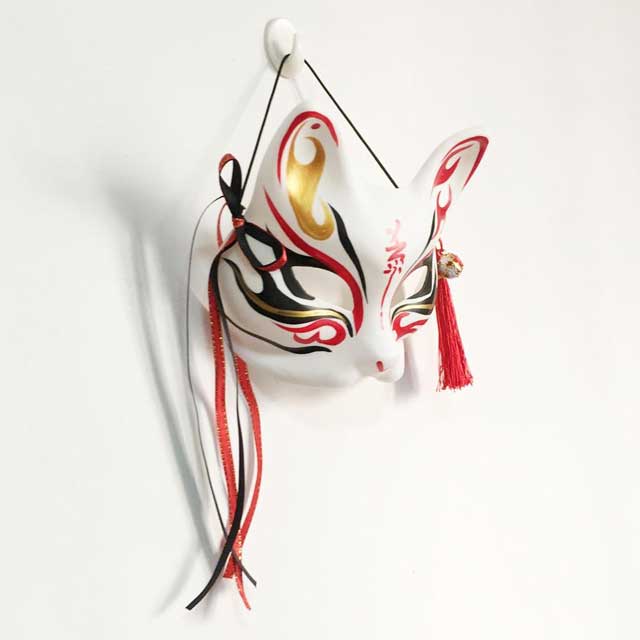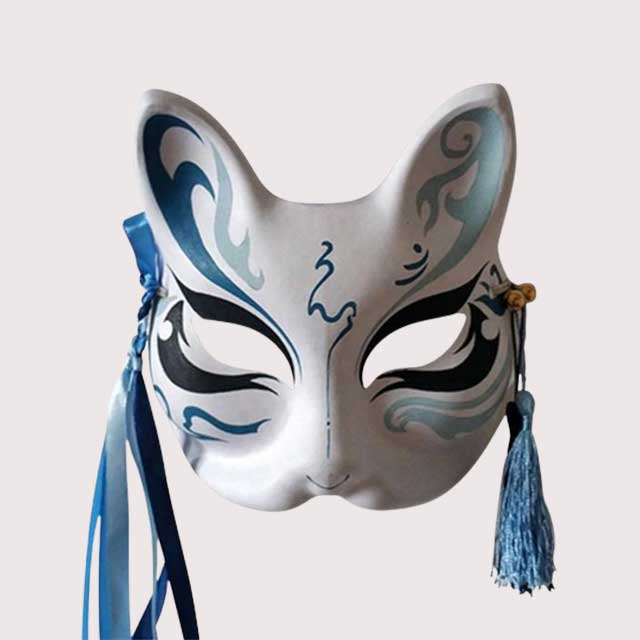I am not the type of person to write reviews but here it goes.
I really needed the clothes for an unexpected party but I chose the fast delivery option and I should say I’m impressed by their fast delivery. The product matches the pictures displayed and I’m impressed by the quality. Kudos to Eiyo Kimono.
Filters
What is a Kitsune Mask?

The Kitsune mask has been a staple in Japanese culture for hundreds of years. It has been used in manga, films, and traditional stories. Chances are, you have seen a kitsune mask in one of these mediums. Kitsune masks are referred to as “fox masks” which are mainly made for festivals and fun. Fox masks are used in the traditional Shinto festivals, they might be used to frighten away demons, to entertain people along a parade route, or to keep fox spirits from disrupting the event. These masks have the face of a fox as the fox is a highly respected animal in Japan. It is associated with gods. This mask is known as Fox Mask in Japan which is mainly made for festivals, cosplay competitions, and for fun. Fox masks are the most popular collectible items that are mainly used for Japanese festivals in the warmer seasons. These masks are also known as fox masks, tosatsu or kitsune which have a religious history in Japan. Kitsune masks are mainly popular in Japan, but have been seen in other Asian countries as well. Kitsune mask is used for mostly festivals, theater and plays of traditional Noh/Kyogen. Kitsune masks feature a lot of colors, patterns and shapes that are used to show the personality of fox spirit.
What is the meaning of a kitsune mask?
The mask is associated with the mythical fox that can have up to nine tails. In the folklore myth, kitsune masks represent wisdom and longevity. People would often wear the fox mask during festivals and events. Most of the time, people would buy it for fun or decoration. Kitsune mask is a traditional Japanese mask used in many festivals and ceremonies. The name kitsune means fox in Japanese, so kitsune masks are often called fox masks. Masks are a very important and traditional part of Japanese culture. It is associated with gods. In Shinto religion, they have a god by the name Inari. This god is highly associated with agriculture, fertility, and protector of rice. According to the religion, foxes are messengers of Inari.
What does a kitsune mask symbolize?
In the religious stories, foxes have special spirits, and that is why people make kitsune masks for various occasions. The mask is likewise broadly popular on New year’s Eve. That is because of an old legend that talks about how all the foxes near Oji shrine could go to it every remaining day of the year in the shape of humans. To honor the story, a celebration referred to as Oji Kitsune-no-gyorestu Fox Parade is annually held between the vicinities of Shozoku Inari Shrine and Oji Inari Shrine in Tokyo. The kitsune masks can symbolize many things, but it mainly symbolizes the fox god in Japan, Inari.
How to make a kitsune mask?
Kitsune masks are made of paper and lacquered. The pattern of this mask is painted by a real artist, which makes it really look like a real fox. Its magnificent appearance has overwhelmed many people to acquire it. The mask itself is usually white with red markings on it and cute fox ears at the top, although other colors have been known to be used. The mask also has whiskers on the sides and the mouth of a fox. The mask is comfortable to wear and it perfectly fits most people due its adjustable strap. Anyone can wear these masks, whether they be Japanese or foreigners, since the whole point of the mask is for entertainment at festivals. The masks cover most of the face, so it is highly unlikely anyone would recognize the person behind the mask anyway.
How to wear a kitsune mask?
To wear a kitsune mask, all one needs to do is find one and size it to your head so that it sits comfortably. Many modern-day kitsune masks will provide an adjustable strap that will allow you to adjust the fitting. While the back strap is often adjustable, be advised that the mask itself is made of the aforementioned paper, which can be fairly fragile. There are other masks that are made for children and active people that are made from plastic, but these masks are just a replica of the real thing. Some Japanese people will wear the masks on the side of their heads because quite often, instead of the mask, they will paint their faces in the kitsune style, so they wear the mask on the side of their heads in order to not mess up the makeup. The kitsune masks are introduced to young Japanese children from a very young age. Many of the traditions and stories in Japanese culture are deep seeded in Japanese children as the stories are made appropriate for children, yet still hold the same ideas of the stories for them to appreciate. If you go to a Japanese festival, quite often you will see small Japanese children wearing kitsune masks. These masks are often adjusted to allow for easier breathing for children.
When was the kitsune mask made?
Historically speaking, these masks have been used since around the 14th century. They were originally used in the Kyogen and Noh performances in the theaters. They were usually part of the intermissions between the Noh acts. They are attractive and funny and were meant to bring a sense of levity to an otherwise serious performance. Foxes have been known to have contradictory behavior, so the masks can represent good and bad, depending on how it's used. All through the historical times, the Japanese network closely lived with foxes. Over time, numerous legends and ideals arose from this companionship which depicted the animals to both have malevolent or benevolent characteristics, relying on the state of affairs they are in. Japanese folklore often depicts foxes to be tough, shapeshifting characters that discover joy in tricking harmless humans, every chance they get. Loads of those stories tell of foxes taking the form of beautiful women to seduce unwitting men, at the same time as different memories narrate how foxes swindle unsuspecting villagers by transforming into reputedly kind monks.
What is the kitsune myth?
Kitsunes are believed to have one to 9 tails. The number of tails a kitsune has shows its age and strength. Kitsunes can be available in specific colors however flip white or gold upon gaining their 9th tail. Nine-tailed foxes, or kyubi no kitsune, are capable of paying attention and seeing the whole thing that is occurring around the world.
Although the term kitsune is used to consult real foxes, kitsune masks are often associated with the spirits. In step with eastern mythology, kitsune can be labeled into categories known as Zenko, which refers to top foxes, and Yako, which refers to mischievous foxes.
The kitsune masks also show the supernatural myths of the polymorphic foxes that can change themselves into other living creatures or objects. Furthermore, the fox’s power grows as they age and acquire wisdom.
There are also myths about how the kitsune would seduce men by transforming into beautiful women. Some legends also talk about how the mischievous demons disguise themselves as monks or old men to swindle some gullible villagers. There is additionally the fox marriage, which is also called the Kitsune no Yomeiri. This Japanese legend comes from rain showers on sunny days and mysterious lights floating at night. Needless to say, the kitsune stories have been passed down for centuries.
What are the 13 types of kitsune?
Many Asian folklore and traditional stories revolve around the elements. In addition to the two classifications, kitsunes are also subject to fall under one of thirteen different species based on their abilities. These subcategories revolve around the elements and are as follows:
- Tengoku (Heaven, Celestial, Light, Prime)
- Kukan (Void or Dark)
- Kaze (Wind)
- Seishin (Spirit)
- Kasai (Fire)
- Chikyu (Earth)
- Kawa (River)
- Umi (Ocean, Sea)
The lowest rank is the Kiko, being the weakest Kitsune. These encompass Kitsune descended from vulnerable households, or as soon as-mundane foxes who've lived lengthy enough in magically-wealthy enough regions to have just carried out complete awareness and a few magical functionality. After attaining 1,000 years of age and gaining its 9th tail, a kitsune turns a white or golden color, becoming a tenko, the maximum powerful form of the kitsune, after which ascends to the heavens. A half-kitsune might be born without a tail or without their fox ears, however by no means without one or the alternative. Due to their displaying features they're regularly known as "Fox Ears" or "Fox Tail' via other natural people.
What is the meaning of the kitsune mask tattoo?
Kitsune and 9 tail foxes can be tattooed in an array of colors, a few are colored to non-public choice, while others choose to follow the traditional meanings. The color of your fox tattoo can show that it's a very good or evil fox. While reddish brown colors are the norm for tattoos, black, gold, and silvery white colors can also be used to symbolize good omens. However, it should be noted that most Japanese people frown upon the concepts of tattoos, as they are commonly associated with the Yakuza mafia. People with tattoos are usually either not allowed in public baths or water parks or are asked to cover them with skin colored tape. There are a number of places throughout Japan that allow tattooed people to enter, however, most of these places are strictly for Yakuza members and not for the foreigner crowd.
How are kitsune masks portrayed in the Demon Slayer anime?
Many kitsune foxes have been seen displayed in characters of manga and anime. One such noted anime that shows the kitsune mask is the anime Demon Slayer: Kimetsu no Yaiba. This anime takes place in the Taisho era of Japan where a secret society of demon slayers have been waging war against demons for centuries. The demons are former humans that are turned into demons by a creature that injects them with his own blood. These supernatural beings feed on humans and possess amazing abilities such as super strength or regeneration. One of these creatures is called a Kitsune demon named Kazuki Shinohara, a 182 year old homosexual demon featured in the anime.
There is also a combat style feature called The Breath of the Kitsune. The Breath of The Kitsune is an unprecedented and devastating combat style to witness for each its energy and for the flexibility of it. For folks who do learn this breath high-quality energy resides on their fingers. Best one family has been graced with the expertise of the breath and that they have in no way shared the breath with all of us as it's far a combat form to truly worry and best intended to be held in possession with the aid of the maximum able swordsmen. This technique also features nine tails, each with its own devastating slash.
Animes also have a prime function in eastern gala's and theaters, so the kitsune anime are frequently utilized by the characters to seem in the dark or mysterious conditions of the show. Dragonball, Naruto, Kakurenbo, Hotarubi no Mori e, and Texhnolyze are the most popular anime shows that have featured kitsune masks.
Are kitsune masks also called Japanese cat masks (Japanese festival masks)?
While similar, the kitsune masks are often confused with neko masks (cat masks). These masks are different though as cat masks often represent luck and prosperity. These masks come from the famous maneki-neko figures which are said to bring good luck. These cat masks are often mistaken for kitsune masks. If you look at both together and compare them, you will notice that the kitsune masks are generally longer and a bit more narrow than the cat masks. These cats are often celebrated during the Manekineko Festival in various cities across Japan. While they look very similar to the kitsune masks, the cat masks do not have the ambiguity that the fox’s traditional stories have. However, both the cats and foxes have a variety of versions that have different meanings.



















